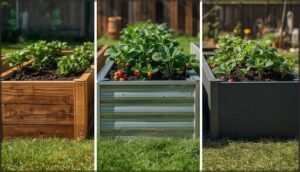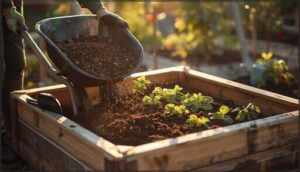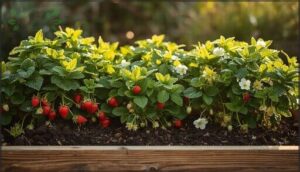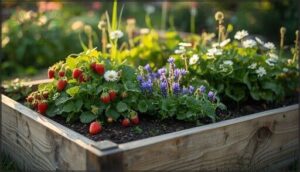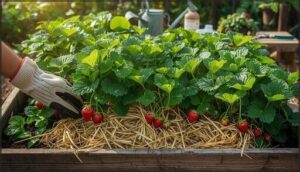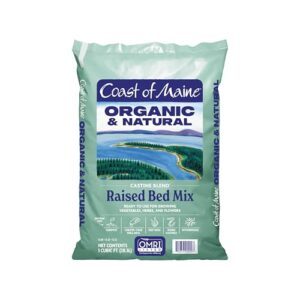This site is supported by our readers. We may earn a commission, at no cost to you, if you purchase through links.
Strawberries don’t play fair in the open ground—every slug, weed, and heavy rain seems to conspire against a bumper harvest. But when you lift those berries into raised beds, the game changes. Suddenly, you control the soil, the drainage, and the pests, and your strawberries respond with bigger yields and fewer headaches.
Whether you’re tired of soggy roots or sick of bending over for every berry, growing strawberries in raised beds hands you the reins. From choosing the right materials to dialing in soil chemistry, you’ll find practical strategies here to turn your patch into a reliable, high-yielding strawberry haven.
Table Of Contents
- Key Takeaways
- Benefits of Growing Strawberries in Raised Beds
- Choosing The Best Raised Bed Type
- Preparing and Filling Raised Beds for Strawberries
- Selecting Strawberry Varieties for Raised Beds
- Planting and Spacing Strawberries in Raised Beds
- Essential Care and Maintenance Tips
- Top 5 Products for Raised Bed Strawberries
- Frequently Asked Questions (FAQs)
- What not to do when growing strawberries?
- How many strawberry plants are in a 4×8 raised bed?
- What is the best thing to put under strawberries?
- Will strawberries come back every year in a planter?
- How much does raised bed construction cost?
- Can strawberries grow in partial shade conditions?
- When is the best time to plant strawberries?
- How long do strawberry plants typically live?
- What tools are needed for strawberry gardening?
- How often should strawberries be replanted in raised beds?
- Conclusion
Key Takeaways
- Raised beds give you full control over drainage, soil pH, and pest pressure, cutting root disease by 60% and boosting yields by 18-25% compared to ground planting.
- Proper spacing (10-18 inches depending on variety) and loamy soil mix with compost create the airflow and nutrient balance strawberries need to produce consistently for 2-3 years before replanting.
- Day-neutral varieties produce fruit continuously from July through October, while June-bearing types concentrate their entire crop into one massive late-June harvest exceeding 2 pounds per plant.
- Strategic mulching, drip irrigation, and disease-resistant cultivars like San Andreas or Albion slash maintenance time by 25% while protecting your harvest from the most common threats.
Benefits of Growing Strawberries in Raised Beds
Growing strawberries in raised beds gives you control over the growing environment in ways traditional ground planting just can’t match. You’ll get better results with less frustration, whether you’re dealing with poor native soil, drainage problems, or backbreaking maintenance.
Let’s look at the key advantages that make raised beds worth the investment.
Improved Drainage and Root Health
Regarding growing healthier strawberries, drainage systems in raised beds give you serious advantages. Better soil drainage creates ideal conditions for sturdy root growth and overall soil health:
- Root aeration increases by 30%, delivering critical root oxygenation
- Soil porosity improves up to 15% in uncompacted raised beds
- Water infiltration rates jump 44.5% compared to ground planting
- Root disease drops 60% with enhanced strawberry raised bed drainage
- Root mass expands 18-25%, directly boosting yields
Proper strawberry care involves using good drainage systems to maintain healthy plants.
Easier Soil Quality Control
Beyond better soil drainage, raised beds let you take the reins on soil quality like never before. You can custom-blend your soil—2 parts topsoil, 2 parts potting soil, 1 part compost—to hit that sweet 5.5 to 6.5 pH range strawberries crave.
Regular soil testing catches nutrient imbalances early, and mulching keeps moisture stable while boosting soil aeration naturally. This approach also fosters soil health management to control pests and diseases.
Reduced Weeds and Pests
Raised beds slash your weeding and pest control workload dramatically. When you layer plastic mulch or landscape fabric as weed barriers, you’ll cut weed problems by up to 90%—that’s real freedom from constant garden battles.
Here’s what makes raised beds your ally in crop protection:
- Soil health stays intact with fewer soil-borne pests infiltrating from below
- Mulch benefits extend beyond weeds, reducing fungal issues by 40%
- Physical separation cuts pest infestations by roughly 60%
- Bird netting installs easier on defined bed edges for complete crop protection
Simplified Harvesting and Maintenance
With pests in check, you’ll appreciate another payoff: labor efficiency that transforms your gardening routine. Harvesting from waist-high beds cuts your picking time by 25% and slashes awkward bending by 60%—that’s ergonomic improvement you’ll feel in your back.
Time savings stack up through simpler mulching, fertilizing strawberry plants, and winter care for strawberries, freeing you to enjoy yield consistency instead of endless maintenance.
Choosing The Best Raised Bed Type
Your raised bed doesn’t need to be fancy, but it does need to last and drain well. The material you choose will affect durability, cost, and how much maintenance you’ll deal with down the road.
Let’s look at the main options so you can pick what works best for your space and budget.
Wooden, Metal, and Plastic Raised Beds
You’ve got three solid choices for raised bed frames when growing strawberries: untreated cedar or redwood (lasting 5 to 10 years), galvanized metal like Birdies (good for 25 to 30 years), and food-grade plastic (10 to 15 years).
Metal beds warm soil faster—think 5 to 8°C hotter—giving you earlier harvests. Wooden beds keep soil temperature steady, while plastic requires the least fussing over maintenance.
Permanent Brick or Concrete Beds
Brick construction or concrete durability turn your strawberry patch into a decades-long investment—lasting over 30 years without rotting, warping, or termite damage. These permanent raised beds give you control that wooden frames can’t match.
- Soil retention walls block burrowing pests like voles and gophers, cutting intrusion by 80%.
- Thermal mass warms soil 2–4°C faster in spring, pushing harvest dates up by 10 days.
- Masonry maintenance costs stay under 5% of your initial expense annually.
- Concrete durability means zero replacement hassles for strawberry plants.
Elevated and DIY Raised Bed Options
With elevated designs, you’ll slash bending strain by 70% while doubling your growing space through vertical gardening tiers. DIY construction using cedar or redwood keeps costs under $100 for a 4×8 bed—32 strawberry plants thriving in loamy soil you control completely.
Raised garden beds transform tight spaces into productive strawberry patches through smart design.
| Raised Bed Materials | Bed Height Options | Space Optimization |
|---|---|---|
| Cedar (rot-resistant) | 12–16″ standard depth | 32 plants per 4×8 bed |
| Redwood (chemical-free) | 18″+ for deep roots | Tiered designs add 50% area |
| Metal frames (durable) | 8″ minimum drainage | Vertical systems save ground space |
| Geo-textile fabric (portable) | Custom heights for accessibility | Corner stacking maximizes yield |
| Composite lumber (long-lasting) | Elevated waist-high platforms | Patio-friendly compact options |
Preparing and Filling Raised Beds for Strawberries
Now that you’ve picked your raised bed, it’s time to fill it with the right soil mix. Strawberries won’t thrive in just any dirt—they need specific conditions to develop strong roots and produce sweet berries.
Let’s break down exactly what goes into creating that perfect growing environment.
Creating Loamy, Well-Drained Soil Mix
You’ll want a soil mix that mimics what strawberries love in the wild: loamy soil with balanced drainage. Aim for roughly 40% sand, 40% silt, and 20% clay—this creates that perfect texture where water moves through without washing away nutrients.
A proven approach is mixing two parts topsoil, two parts potting soil, and one part compost. This soil preparation gives your raised beds the drainage systems strawberries need while maintaining structure.
Adding Organic Matter and Compost
Compost benefits go beyond basic nutrition—you’re building a living ecosystem. Adding two to three inches of compost annually boosts your soil’s water-holding capacity by 18–25% and increases microbial diversity by over 30%.
Adding 2–3 inches of compost each year transforms your soil into a thriving ecosystem with boosted water retention and microbial diversity
This organic matter fuels nutrient cycling that keeps feeding your plants naturally. Think of it as slow-release organic fertilizer that your strawberries can tap into all season long.
Adjusting Soil PH for Strawberries
Getting soil pH right matters—strawberries thrive between 5.5 and 6.5, with 6.2 being the sweet spot for maximum yield. Test your raised beds before planting, then add lime to raise pH or sulfur to lower it.
Work amendments into the top six inches and wait a few months for stabilization. This pH balancing ensures your strawberry plants can actually absorb nutrients from that organic fertilizer and compost you’ve added.
Selecting Strawberry Varieties for Raised Beds
Picking the right strawberry variety makes all the difference when you’re working with raised beds. You’ll want plants that can handle your climate, resist common diseases, and match your harvest expectations.
Let’s look at the main types you should consider for your setup.
Disease-Resistant and Hardy Varieties
Your best defense against crop loss starts with selecting resistant varieties that can handle whatever your garden throws at them. UC Davis released five Fusarium-resistant cultivars in 2023, addressing a weakness that’s plagued over half of California’s strawberry plants since 2014. Hardy cultivars from breeding programs undergo years of rigorous testing before they reach your raised bed.
Consider these proven performers for disease tolerance:
- San Andreas fights spider mites, gray mold, and powdery mildew effectively
- Elsanta resists gray mold, leaf spot, and shows moderate root rot tolerance
- Galletta tolerates leaf disease and red stele, yielding 13,000 pounds per acre
- Florida Radiance recorded just 1.4% disease incidence in multi-year assessments
- Albion maintains 80% survival rates with intermediate disease resistance
These resistant varieties reduce your need for fungicides while extending productive plant life and boosting profitability through better harvests.
Day-Neutral, Ever-Bearing, and June-Bearing Types
Beyond disease resistance, your strawberry variety choice determines when you’ll harvest and how much you’ll gather. Day-neutral varieties like ‘Albion’ produce fruit continuously from July through October, yielding 1 to 2 pounds per plant annually.
Ever-bearing types deliver two or three smaller harvests throughout the season.
June-bearing varieties concentrate their crop in one massive late-June harvest, often exceeding 2 pounds per plant.
Alpine and Compact Strawberry Options
If smaller footprints suit your raised beds better, alpine strawberries like Fragaria vesca give you intensely aromatic, pineapple-flavored berries weighing just 1 gram each. These runnerless plants form tidy foot-wide mounds and fruit from May through frost.
Compact everbearing varieties pack 2 to 3 pounds per season into dense growth, resisting powdery mildew while freeing up space for companion herbs or greens.
Planting and Spacing Strawberries in Raised Beds
Getting your strawberry plants in the ground correctly makes all the difference between a thriving bed and a disappointing harvest. You’ll need to understand how to handle different plant types, space them for maximum airflow and yield, and consider what other plants might help them succeed.
Let’s break down the planting process so you can set up your raised bed for years of productive growth.
Planting Crowns, Bare Roots, and Container Plants
You’ve got three ways to start your strawberry patch in raised beds: bare-root crowns, container plants, or established crowns. Bare roots cost 20-40% less and hit 95-100% survival rates when planted with roots spread wide and crowns at soil level. Container plants jump ahead faster but need hardening off first.
Here’s what matters for strong root development and crown establishment:
- Keep bare-root crowns cool and moist until planting
- Position crowns exactly at soil surface—not buried, not exposed
- Spread roots naturally during planting for better nutrient uptake
- Harden off container plants gradually for proper soil acclimation
Proper Spacing for Airflow and Yield
When growing strawberries in raised beds, spacing is key to disease prevention and yield optimization. The density of your plants directly affects air circulation around each patch, which is crucial for preventing fungal issues.
| Strawberry Type | Plant Spacing | Row Spacing | Density Trade-off | Best For |
|---|---|---|---|---|
| Day-Neutral | 10 inches | 18-24 inches | Higher yield, smaller berries | Continuous harvest |
| Everbearing | 12 inches | 18-24 inches | Balanced productivity | Home gardens |
| June-Bearing | 18 inches | 18-24 inches | Larger berries, runner growth | Maximum fruit size |
| Square-Foot Method | 12 inches (1-2/sq ft) | N/A | Space-efficient | Small raised beds |
| Dense Planting | 8 inches | 18 inches | Quick fill, disease risk | Short-term yield |
Day-neutral strawberry plants thrive with a 10-inch spacing, while June-bearing varieties require 18 inches to accommodate their larger size. Tighter arrangements, between 8 and 12 inches, can boost early yields but may increase humidity around the foliage, making plants more susceptible to Botrytis and rot. Raised beds inherently improve airflow compared to ground planting, allowing for closer spacing without compromising plant health.
Staggered rows make efficient use of space while maintaining the critical 18-24 inch row spacing that prevents stagnant air pockets. Overcrowded beds often require frequent runner pruning and thinning to manage disease pressure. Wider spacing supports vigorous plants and larger berries, though it may take longer for bare soil to fill in.
Allow runners to establish naturally to increase plant density over time, reducing the need for frequent replanting. Remove older plants every 2-3 years to maintain productivity, and thin regularly to keep the ideal 8-12 inch spacing between strawberry plants.
Companion Planting Benefits
Strategic companion plants transform your strawberry patch into a high-functioning ecosystem. Borage and yarrow boost pollinator attraction, increasing yields by roughly 32%, while alliums cut pest control needs by deterring beetles.
Legumes like clover provide soil enrichment through nitrogen fixation and microclimate regulation by stabilizing moisture.
This biodiversity enhancement approach protects raised beds naturally, reducing chemical inputs while supporting healthier strawberry plants.
Essential Care and Maintenance Tips
Once your strawberries are in the ground, the real work begins—but it’s simpler than you might think. Good care habits make the difference between a modest harvest and baskets overflowing with berries.
Let’s walk through the techniques that keep your plants thriving from spring through winter.
Watering and Mulching Techniques
Water your strawberries in raised beds deeply 1–2 inches per week, increasing to 2 inches during fruiting. Check soil moisture 2 inches down—it should feel consistently moist but never soggy.
- Install drip irrigation systems for 50% better water conservation than overhead watering
- Water in the morning to keep leaves dry and prevent fungal issues
- Apply 1–2 inches of straw or shredded leaf mulch around crowns
- Use mulching raised beds to retain 25% more soil moisture
- Monitor sandy soil more frequently due to faster drainage
Fertilizing and Pruning Strategies
Feed your strawberry plants with balanced 10-10-10 fertilizer. Broadcast 20 pounds per 1,000 square feet before planting, then repeat post-harvest for June-bearing types. Day-neutral varieties need steady fertilizing every six weeks from mid-June through August.
Prune runners regularly to channel energy into fruit production, and remove the top 3–4 inches of shoots during summer to boost lateral branching and overall plant vigor.
Managing Runners, Pests, and Diseases
Managing strawberry runners is essential to prevent overcrowding and disease. Thin runners weekly during the first year to increase your marketable yield by 30%. Pin four daughter plants to the soil with wire, then cut the rest.
For pest control, use bird netting to deter feathered thieves and Bt sprays for caterpillars. Morning watering and good airflow are crucial to preventing fungal infections and maintaining soil health.
Winter Care and Plant Longevity
Your strawberry patch can survive harsh winters with proper frost protection. Apply 4-6 inches of straw mulch for plant insulation after several nights below 20°F—this root preservation technique offsets the colder microclimate in raised beds.
Cold hardening occurs naturally before you mulch, so don’t rush it. Winter mulching and consistent winter care help overwintering strawberry plants produce strong yields for 3-5 years.
Top 5 Products for Raised Bed Strawberries
The right products can make the difference between a struggling strawberry patch and a thriving harvest. You don’t need a garage full of equipment, but a few well-chosen tools will save you time and protect your investment.
Here are five essentials that address the most common challenges you’ll face growing strawberries in raised beds.
1. Self Watering Garden Planter Box
You’re taking charge of your strawberry harvest when you choose a self-watering planter box—this 44.9-inch model delivers the freedom you need. The built-in water reservoir slashes your watering effort by up to 80% while keeping soil moisture consistent for thriving strawberry plants.
Perfect for urban gardening on patios or balconies, it transforms raised bed strawberry growing into a low-maintenance victory. The water gauge removes guesswork, and elevated design naturally deters slugs.
You’ll see healthier roots and sweeter berries with less fuss.
Best For: Urban gardeners and busy plant lovers who want fresh strawberries without daily watering hassles, especially on balconies or patios.
- Cuts watering frequency by up to 80% with a built-in reservoir that can sustain plants for weeks
- Promotes healthier strawberry plants with consistent moisture and better root development for sweeter berries
- Elevated design naturally reduces pests like slugs while the drier soil surface discourages weeds
- Some customers reported receiving damaged products or breaking dividers during assembly
- Gets heavy and difficult to move once filled with soil
- Drainage system and water reservoir issues reported by some users
2. Organic Raised Bed Garden Soil
Once you’ve got the right container, soil quality becomes your next power move. Coast of Maine’s Organic Raised Bed Garden Soil gives you premium ingredients like worm castings, mycorrhizae, and biochar in one ready-to-use mix.
You’ll support nutrient cycling and microbial health without fussing over ratios—the 1 cubic foot bag costs $25.90 and delivers excellent drainage plus water retention.
This soil composition fuels organic gardening success, letting you skip synthetic chemicals while building living, biodiverse raised beds that produce sweeter strawberries season after season.
Best For: Gardeners who want a no-fuss, premium organic soil that’s ready to use right out of the bag for raised beds, containers, or in-ground planting of vegetables, herbs, and flowers.
- Packed with high-quality ingredients like worm castings, mycorrhizae, and biochar that support healthy microbial activity and nutrient-rich soil without extra mixing
- Balances water retention and drainage perfectly, so your plants get moisture when they need it without sitting in soggy soil
- OMRI-certified organic with all-natural components, meaning you skip synthetic chemicals while building living soil that gets better over time
- The 1 cubic foot bag is on the smaller side, so you’ll need multiple bags for larger raised beds or gardens
- At $25.90 per bag, it’s pricier than basic potting mixes, which might add up for budget-conscious gardeners
- You may still need to add specific fertilizers or amendments depending on what you’re growing and your soil’s unique needs
3. Easy Soil Test Kit Solution
After filling your beds with quality soil, you’ll want to confirm what you’re actually working with—that’s where MySoil’s Easy Soil Test Kit delivers clarity.
For $31.99, you’ll measure 13 plant-available nutrient levels plus pH, then receive custom fertilizer guidance within a week.
The kit’s 94% lab-grade accuracy lets you dial in that 5.5-6.5 pH sweet spot strawberries crave, skip guesswork on nitrogen and potassium, and stop wasting money on unnecessary amendments while maximizing your berry harvest.
Best For: Home gardeners who want lab-quality soil analysis without the lab prices, especially if you’re growing strawberries or vegetables in raised beds and need precise nutrient data to stop guessing what your plants actually need.
- Tests 13 nutrients plus pH with 94% lab accuracy for $32, so you know exactly what to add instead of dumping random fertilizers and hoping something works.
- Comes with custom fertilizer recommendations based on your actual results, which means you’ll spend less money fixing problems that don’t exist.
- Super simple process—collect soil, mail it in the prepaid envelope, get detailed results in about a week with dedicated support if you have questions.
- Only works for U.S. addresses since the prepaid envelope won’t mail internationally, so you’re out of luck if you’re gardening elsewhere.
- Takes 6-8 days to get results back, which feels slow if you’re itching to plant tomorrow and need answers now.
- Single-use kit means you’ll need to buy another one next season if you want to track how your soil changes over time.
4. Organic All Purpose Plant Fertilizer
Once your soil’s chemistry checks out, you’ll need consistent nutrient delivery—and that’s where Jobe’s Organics All Purpose Fertilizer earns its spot. This 4-4-4 NPK blend runs about $20 for 16 pounds and feeds your strawberries through gentle microbial breakdown instead of chemical spikes.
You’re building real soil health here: better water retention, stronger root systems, and beneficial microbe balance that suppresses disease while boosting fruit quality.
Apply two tablespoons per plant twice per season, and you’ll skip the burn risk synthetic fertilizers bring while supporting genuine organic gardening practices.
Best For: Gardeners who want an easy, organic way to boost plant health and yields in outdoor beds without synthetic chemicals.
- Promotes strong root growth and vibrant plants with balanced nutrients.
- Safe for organic food production and improves soil quality over time.
- Easy to measure and apply, with a slow-release formula that reduces burn risk.
- Has a strong earthy smell that some may find unpleasant.
- Not suitable for indoor use and may attract pets.
- Exact ingredient breakdown isn’t fully disclosed.
5. Heavy Duty Bird Protection Netting
Bird netting is your frontline defense in crop protection—think of it as a fortress for your strawberries. Netting installation isn’t just about tossing mesh over raised beds; you need tight anchoring and zero gaps, or birds will find their way in. Heavy duty netting materials like UV-stabilized nylon stand up to sun, wind, and pests for years.
Bird deterrents and pest control work best when you combine netting with regular checks. Protecting strawberries from pests keeps your harvest safe and your garden thriving.
Best For: Home gardeners and commercial growers who need reliable protection for fruit, vegetables, and plants against birds and larger animals.
- Durable nylon netting resists tearing and lasts for years outdoors.
- Effectively blocks birds, deer, squirrels, and other animals from crops.
- Easy to install and versatile for gardens, ponds, or various outdoor setups.
- Mesh size may not stop small birds from getting through.
- Can be tricky to fit over irregularly shaped areas or delicate plants.
- May require extra support or weighting to prevent wind damage.
Frequently Asked Questions (FAQs)
What not to do when growing strawberries?
If you plant crowns too deep, water like a monsoon, or crowd plants shoulder-to-shoulder, you’re courting disaster—think fruit rot, soil contamination, and pest mismanagement.
Overlook winter care and disease prevention, and you’ll watch yields vanish.
How many strawberry plants are in a 4×8 raised bed?
You can fit 24 to 32 strawberry plants in a 4×8 raised bed with 12-inch spacing.
This Plant Density ensures strong Strawberry Yield and healthy Fruit Production, turning your raised bed into a productive strawberry patch.
What is the best thing to put under strawberries?
The best thing to put under strawberries is a layer of straw mulch or aged wood chips. Both options boost drainage, suppress weeds, and improve soil quality.
Adding compost layers beneath crowns also strengthens root health and fruit yield.
Will strawberries come back every year in a planter?
Yes, strawberries are perennial plants that return yearly in planters with proper winter protection and container rejuvenation. However, planter longevity usually spans 2–3 years before root health declines and productivity drops markedly.
How much does raised bed construction cost?
Building your own raised beds slashes costs dramatically—DIY wood projects average $50 to $210 in material costs, while professional labor expenses push that figure beyond $100 per square foot, making budget planning essential.
Can strawberries grow in partial shade conditions?
Strawberries can survive in partial shade, but you’ll sacrifice about 50% of your yield and get smaller, less sweet fruit.
They need at least 6 hours of direct sunlight for ideal growth and flavor.
When is the best time to plant strawberries?
Plant strawberries in early spring after soil warms to 50°F, or fall in warmer climate zones.
Timing depends on frost dates and regional planting schedules—bare roots tolerate cooler soil than container-grown varieties.
How long do strawberry plants typically live?
Most strawberry plants stay productive for 2-3 years before fruit production drops off. With outstanding care, they can survive 5-6 years, but you’ll see strawberry senescence kick in after year three.
What tools are needed for strawberry gardening?
You’ll need basic gardening tools like trowels and hand forks for soil preparation, drip irrigation or soaker hoses for watering, plus raised bed kits, mulch, bird netting, and a garden stool for comfort.
How often should strawberries be replanted in raised beds?
You’ll want to replant every three to four years to maintain peak productivity.
After that, yields usually drop by 20-30%, disease pressure builds up, and fruit quality declines noticeably despite your best care efforts.
Conclusion
Your strawberries won’t tolerate neglect in the open ground, but raised beds shift the odds squarely in your favor. You’ve seized control of drainage, soil health, and pest pressure—three battles won before the first runner spreads.
Growing strawberries in raised beds isn’t just easier maintenance; it’s a deliberate strategy for predictable, generous harvests. Build your bed, fill it right, and watch your berry patch transform from seasonal gamble into a dependable source of sweetness you can count on every year.
- https://extension.okstate.edu/fact-sheets/sustainable-landscapes-creating-a-hugelkultur-for-gardening-with-stormwater-management-benefits.html
- https://www.allaboutgardening.com/overwinter-strawberries/
- https://homeguides.sfgate.com/way-run-raised-bed-garden-91675.html
- https://www.indianaberry.com/strawberries.html
- https://www.pubs.ext.vt.edu/426/426-840/426-840.html


